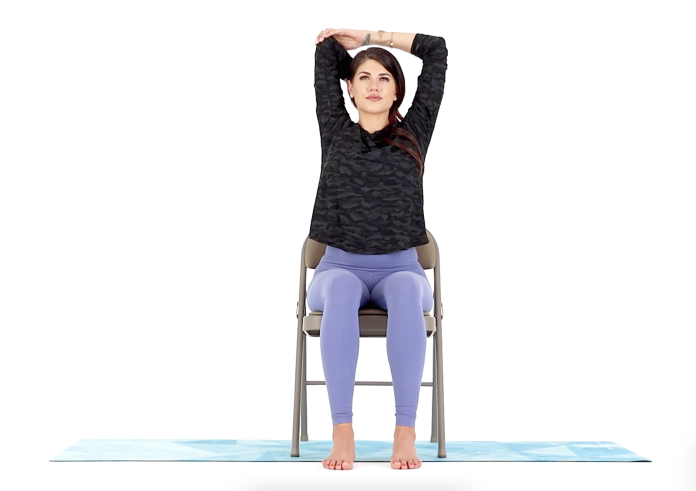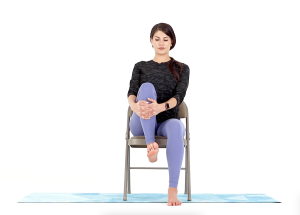Yoga can help you stretch, strengthen, tone, de-stress and peel back the layers to becoming your best self. What does the word yoga actually mean? The word yoga means to “unite” referring to the mind, body and spirit.
Today, yoga is commonly most known for its physical practice. It’s a combination of breathing exercises, meditation, physical postures and some lifestyle elements. It’s important to remember that everyone is on their own unique yoga journey. It doesn’t have to be overwhelming. It doesn’t matter if your heels don’t touch the mat in downward dog or if your hands don’t touch the floor in a forward fold. As long as you’re practicing and you feel good, that’s good!
Chair yoga, is an easy, gentle, and fast way to wake up the body and get moving. This type of yoga is particularly helpful for beginners, desk workers and seniors looking to work some gentle movement into their day.
Below are some simple steps you can take to perform chair yoga, wherever you are, whether you are at home, at work or even on an airplane!
Getting started:
Grab a chair with a back but no sides. Take a seat on your chair with feet flat on the ground. With 90 degrees in your knees, sit up tall, place your hand on your thighs, relax your shoulders, take deep breaths in and out through your nose and feel yourself relax. Continue to breathe smooth and deep, in and out through your nose throughout your practice and the rest of your day to invite a sense of peace and grounding.
Neck, chest, back stretches:
Lower your chin down to your chest, round your spine and let your head become heavy so you feel yourself soften with each exhale, this is a seated cat back. With your hands holding on to your knees, lift your chin up and pull your chest forward as you roll your shoulders open and lift your chin up, like a seated cow pose. These cat and cow spinal moves can be done anytime throughout the day to release tension in your spine.
Ankle and hamstring stretches:
Lift your right knee up, hold on to your shin and alternate between flexing and pointing your foot, waking up the muscles in your calf, then draw circles in both directions with your toes creating mobility and awareness. Next, straighten out your right leg and flex your foot so your heel is resting on the ground in front of you. From here, hinge forward at your hips to stretch your hamstring. Always remember not to strain, just relax, and listen to your body. Take your time getting back up. Notice how your right side feels. Repeat the same steps on your left side. Notice how each side feels after you complete each side.
Chair lunges:
Turn your whole body to the right and use the back of your chair to provide balance and support needed. Adjust yourself to lower your left knee to the ground so the chair is supporting your right thigh and hip. Stay with your left knee towards the ground or you can go deeper by stretching your left leg back into a deeper lunge. You can also extend your left arm towards the ceiling for an extra stretch.
Twists:
For a twist, place both hands on your right thigh, being careful not to arch. Place your right hand on the back of your chair as you turn your upper body towards the right. Place your hands wherever you need for support but don’t strain. Just focus on your deep breath, creating space and releasing tension along the muscles in your chest and back.
Warriors Stretch:
Next, try a warrior two, spin your back heel down and turn your body towards the left so that your right hip is opening up. If you prefer, you can take your hands to your hips here, or you can reach your arms front and back like a warrior! Try to turn your back toes in so your heel is the furthest thing away from your body. Find the warrior that serves you while being completely supported by the chair. For a reverse warrior, reach your right arm up to the ceiling, stretching up through your right fingertips creating length on your right side. Breathe deeply into the stretch. Then for extended side angle, from here lower your right forearm down to rest on your right thigh as you reach your left arm up. Keep your left shoulder rolling open, being careful not to cave in towards the ground. To come out use your core strength to rise up.
Repeat the same steps on the other side for chair lunges, twists and warriors stretch.
Ragdoll fold:
Facing forward on your chair, sit up straight and move your feet wide apart for more stability and space for your upper body. Slowly bend at your hips to lower your body down toward the ground. Place your hands on the floor and allow your head to hang heavy. Relax your face, arms, and shoulders. Breathe deeply as you feel your breath releasing tension in your back, shoulders or hips. This is an extremely relaxing pose that can be used throughout the day to calm a racing or anxious mind. Take your time to slowly come out, supporting yourself with your arms and being mindful to breathe as you rise.
Namaste:
From seated, take a moment to settle in and ground your down through your feet. With your face relaxed and shoulders soft, take a few deep breaths in and out. Close your eyes and bring your hands together like a prayer in front of your heart. From this place of peace within me to this place of peace to you, Namaste.
Remember, yoga is supportive, and it’s non-judgmental. It’s not egotistical and it’s not a scale of measurement. Yoga is a peaceful world of possibility that connects people to themselves and each other. Even five minutes of daily yoga is better for you than one hour, once a week. Your daily practice is your strongest practice and the fastest way to see results in your strength, flexibility, mind, and body.


























